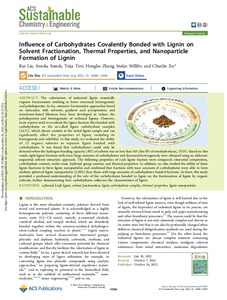Influence of Carbohydrates Covalently Bonded with Lignin on Solvent Fractionation, Thermal Properties, and Nanoparticle Formation of Lignin
Liu Rui; Smeds Annika; Tirri Teija; Zhang Hongbo; Willfor Stefan; Xu Chunlin
https://urn.fi/URN:NBN:fi-fe2022122172990
Tiivistelmä
The valorization of industrial lignin essentially requires fractionation resulting in lower structural heterogeneity and polydispersity. So far, extensive fractionation approaches based on extraction with solvents, gradient acid precipitation, and membrane-based filtration have been developed to reduce the polydispersity and heterogeneity of technical lignins. However, most reports tend to overlook the lignin fraction that bonded with carbohydrates or the so-called lignin carbohydrate complex (LCC), which always coexists in the initial lignin sample and can significantly affect the properties of lignin, including its homogeneity and solubility. In this study, we evaluated the ability of 13 organic solvents to separate lignin bonded with carbohydrates. It was found that carbohydrates could only be detected when the hydrogen bonding capacity (δH) of solvent was no less than 8.0 (the δH of tetrahydrofuran, THF). Based on this result, eight lignin fractions with trace/large amounts of carbohydrates and decreased heterogeneity were obtained using an elaborate sequential solvent extraction approach. The following properties of each lignin fraction were compared: elemental composition, carbohydrate content, molar mass, hydroxyl group content, and thermal properties. In addition, we also studied the ability of these lignin fractions to form lignin nanoparticles and confirmed that fractions with trace amounts of carbohydrates were able to form uniform spherical lignin nanoparticles (LNPs) than those with large amounts of carbohydrates bonded fractions. In short, this study provided a profound understanding of the role of the carbohydrates bonded to lignin on the fractionation of lignin by organic solvents, further demonstrating how carbohydrates influence the characteristics of lignin.
Kokoelmat
- Rinnakkaistallenteet [27094]
